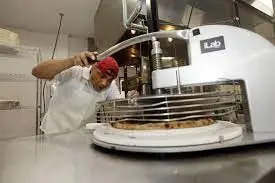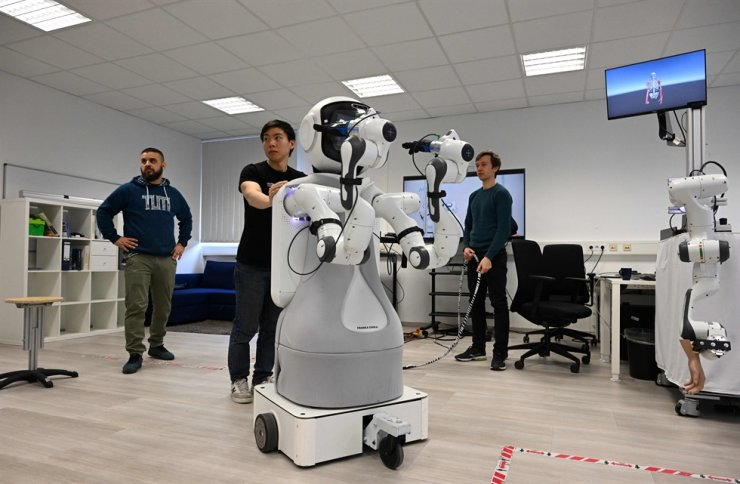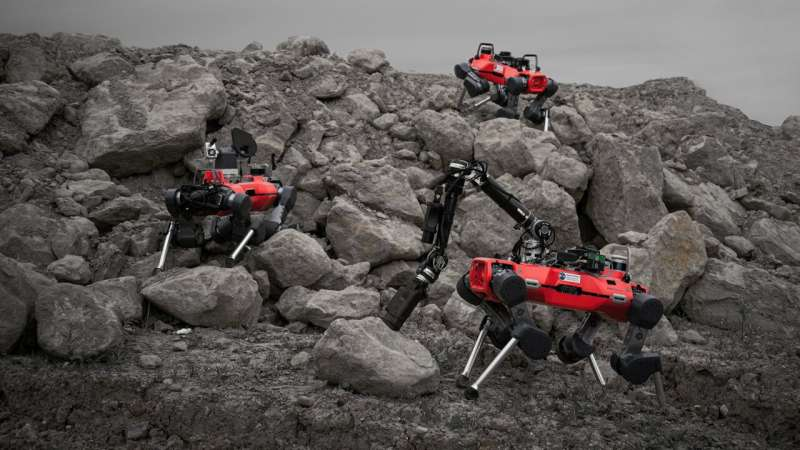To prepare a cup of cappuccino, Jarvis travels slowly but methodically from one station to the next. Robots to prepare coffee and pizza. Jarvis prepares the espresso, pours the milk, steams the foam, and assembles everything before adding a skillfully crafted foam leaf on top.
The outcome is a finished cup of cappuccino.
What distinguishes this cappuccino from others? its creator. At Artly in Pike Place Market, Jarvis is a robotic arm rather than a human barista.
While Jarvis is occupied, human staff members concentrate on interacting with clients, introducing newbies to the concept, and taking orders via tablet.
The 2020-founded Seattle-based robotics business Artly operates seven facilities in California, Oregon, and Washington. A distinctive barista bot with its own name, gender, voice, accent, and personality is the center of attention at each location. As they learn from a different human barista at each site, the robot’s methods vary.

Although it is fascinating to witness how the robot makes coffee, the innovation was driven by urgent commercial demands. Even before the pandemic struck and presented new difficulties, cost concerns and frequent personnel turnover in the food services industry prompted Artly and others to provide automated solutions to restaurants and companies.
After only a few years in business, Artly CEO Meng Wang claimed that by cutting out the biggest cost in the food industry—labor—the business has been able to maintain excellent operating margins.
In addition to a barista robot like Jarvis, Artly requires one employee for a coffee business that would require two or three baristas. According to Wang, Artly uses the money it saves on labor to buy additional high-quality coffee.
Artly is not the only company that use robot assistance for food preparation. Pizza, a mainstay of the American diet, is the focus of automation solutions provided by Picnic, another Seattle-based business. With metered toppings, its food prep unit can make up to 100 pizzas in one hour.
Pizzas have been built by Picnic’s robots in a variety of locations since the company was formed in 2016, including Seattle’s T-Mobile Park and the Las Vegas Convention Center. The business has noticed an increase in interest in its robots. This summer, Picnic announced collaborations with a Domino’s outlet in Berlin and the West Seattle pizzeria Moto.
These robots’ manufacturers boast that their automated solutions would increase productivity and cut costs. According to Clayton Wood, CEO of Picnic, automating pizza assembling can help businesses cut down on food waste and possibly save money. For instance, it makes the toppings more evenly distributed.
Pizza-making can be more economical by automating the process with predetermined topping amounts, according to Wood.
Automated solutions also close a hiring and retention gap. According to Wood, positions in the food industry can be “tedious and can be dangerous, and there’s very rapid turnover.” “There is no room for progress, and the working environment is not good.”
According to Geoff Harris, a Picnic investor and the co-founder and managing partner of the venture capital firm Flying Fish Partners, problems with efficiency and turnover in the food business predate COVID-19.
However, as restaurants shuttered due to the pandemic, the need increased. Many employees were laid off or furloughed and did not go back to the food industry.
Staffing levels at eating and drinking establishments remain below their pre-pandemic levels as demand for labor nationally remains high, according to a National Restaurant Association analysis of U.S. Labor of Bureau Statistics data in November.
human contact
However, there are some situations where people cannot replace robots. Joe Yang, co-founder and chief coffee officer of Artly and owner of a number of coffee shops in Portland, has firsthand experience with this.
Yang used his own stores to test the beta version of Jarvis. The robot barista first piqued the interest and excitement of his customers, but the service was slower than it would have been with a human barista. Customers wanted to feel connected to the person pouring their coffee, he claimed.
Customers expect to be helped by a human when they visit a coffee shop, according to Yang.
As a result, Artly has prioritized opening sites in commercial office buildings and shopping malls rather than traditional coffee shops.
In regions where there are no coffee shops due to the epidemic or where Starbucks locations have closed, Artly has also found an opportunity to grow.
“There were several ‘coffee deserts’ during COVID-19, and the competition is obviously much less than previously,” Wang added.
For instance, in May 2021, the company’s first shop in Portland, Oregon, opened, following the departure of the previous coffee operator due to a staffing shortage. Similar to this, in December 2021, Jarvis established a residence at Stoneridge Shopping Center in Pleasanton, California, because there wasn’t a coffee shop there.
Customers had no other coffee options once Starbucks departed because it was the only coffee supplier in some locations, according to CEO Wang. This was the situation in San Antonio’s Stonestown Galleria Shopping Center.
CEO Wang of Artly claimed that money has not been an issue for the business. It completed a $8.5 million investment round this year and a $1.5 million round the previous year. Early-stage investments were made in both rounds.
Picnic and Artly are both still fledgling businesses. And all parties intend to grow the business despite any potential economic difficulties.
The reveal date is still pending, but Picnic and Moto have teamed together once more to create a food prep station at the pizzeria’s downtown location. Wood and Harris predict further collaborations in the future.
The next stage at Artly, according to Wang, will be franchising when the barista bots are more consistent and dependable at brewing coffee, albeit that objective is still a few years away. The company intends to scale by 2023
Read More
- A secure global supply chain is possible with blockchain.
- Using electricity to locate materials that can “learn” is shocking to the system
- Cracking of Eggshells using computing power
- A Way To Help Reduce Global Warming Is Through Solar Energy Conversion



